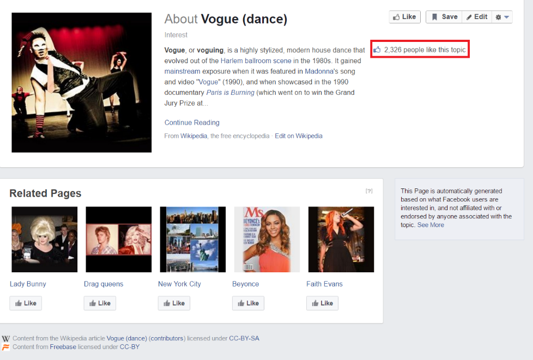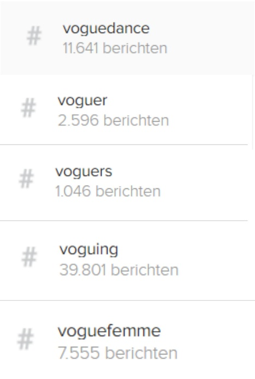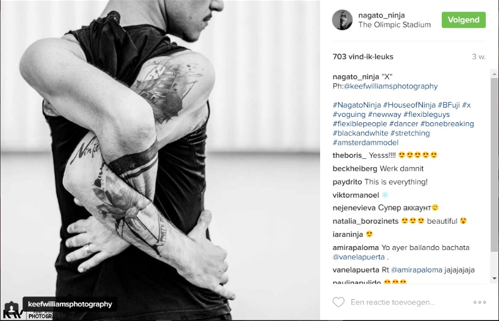
Voguing and social media
Social media have been the most important factor in propelling the voguing culture to become a worldwide phenomenon. It has played a decisive role in its globalization, because it allows people from all over the world to connect and share their ideas with each other (Yigit & Tarman, 2013). What do voguers post on social media and why do they post these things? In this article, we will deal with the activities of vogue dancers on social media. While analyzing the online voguing community, we will apply Castells' (2011) theory about network societies.
Voguing as an online community
On social media platforms, many topics and interests are represented, for example in the form of pages or groups. Interests about multimodal messages are spread across the globe. The interest of vogue dance is also one that can be found on multiple social media platforms.
As can be seen in figure 9, over 2000 Facebook users “like” vogue dance, which already suggests that there are voguers active on social media. Not only are there many “likers” on the interest page of the dance style, but also there are groups and pages related to voguing all over Facebook. There are around 80 groups and 100 pages to be found about vogue dance (December, 2016).
After searching for hashtags linked to voguing on Instagram (figure 10), we discovered that also on that platform there are at least over 62,000 posts about it.

Figure 9: The interest of 'vogue dance' on Facebook
The numbers are not extremely high, but they do demonstrate that an active online community exists. An online community can be described as a group of people who have something meaningful in common connected through the internet (Kim, 2000). According to Castells (2011), globalization shapes new forms of society, which includes the phenomenon that there can also be online communities instead of only local communities.

Figure 10: Hashtags about voguing on Instagram.
Strike a post
As seen, there are quite a few posts related to the 'art of vogue', as some voguers like to call their dance style. What is it exactly that they post? Most common are videos of the artists performing a vogue dance. This dancing is either staged on a catwalk, a dance studio, or just surrounded by a group of people who cheer the voguer on. Due to the presence of an audience in the majority of these videos, the concept of live performances is notable. The audience is an active participant in the clips; they are cheering on the voguers who are performing.
Next to videos in which they are performing their art, they also post pictures. In most cases the voguers capture dance moves in their pictures (figure 11). Another thing we see frequently among voguers is that they post selfies. Selfies play a role in identity construction (Levin, 2014). Through selfies, people choose how they want to present themselves, online and offline. Voguers also use selfies to construct their identity as a vogue dancer. According to our own observations, the “duckface” is often present in these selfies.
Goals and motives
Voguers often post videos of themselves dancing, pictures of themselves doing dance moves and selfies. There are multiple reasons for them to post these things.
For one, they want to “expose the art form itself” (@davon_dyu). They are proud of their dance style and want others around the globe to get familiar with it. They believe social media has played and continues to play a huge part in the spread of voguing. As popular voguers, they want to contribute to that.
Another important motive for voguers is that they get to show their love and passion for the dance style to as many people as possible (@nagato_ninja). Voguing is a way to express oneself and voguers want to share this passion and expression of themselves with others online. There was one thing that definitely stood out to us, which is the drive for voguers to be discovered. This phenomenon is illustrated by the following quote:
“The social media are a good way to show myself and my work to people, and it is definitely a way to work with my art. People start to follow you and a part of these people are Dance Event organizers, Dance School organizers, television show Directors and if they like you, they can call you to work" (@nagato_ninja).
Voguers want to turn their hobby into their profession, which is why high popularity is important to them. By gaining more followers and likers online, they might just come in contact with the right person. They want to be discovered by celebrities and go on tour with them (@davon_dyu). Rihanna, Beyoncé and Madonna have been mentioned multiple times as they have brought voguers along with them on their tours before.
Online voguing community
Due to the activeness of voguers on social media and the fact that they have something in common, it is evident that an online-voguing community exists. As Castells (2011) described in his book, our society has shifted into a network society. A community now is not only something small and local, but also global and online. The online voguing community is an example of this phenomenon.
The members of this community mostly post videos in which they are performing their art, pictures in which they do dance moves linked to vogue dance and selfies. By posting these things, voguers try to contribute to spreading voguing around the world. They also want to show others their passion for the dance style. However, what they really try to achieve is to be discovered by celebrities and turn voguing into their profession.
References
Castells, M. (2011). The Rise of the Network Society: The Information Age: Economy, Society, and Culture, Volume 1. Chichester: John Wiley & Sons.
Kim, A. J. (2000). Community Building on the Web: Secret Strategies for Successful Online Communities. Boston: Addison-Wesley Longman Publishing Co.
Levin, A. (2014). The Selfie in the Age of Digital Recursion. InVisible Culture(20).
Yigit, M. F., & Tarman, B. (2013). The Impact of Social Media on Globalization, Democratization and Participative Citizenship. Journal of Social Science Education, 75-80.
